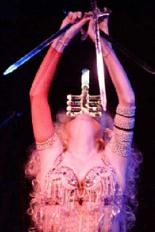Sword Swallowing
Below you will find information on sword swallowing and bellydancing.
Sword swallowing started in India around 2000 B.C.E. It was originally done by Fakirs and Shamans or Priests as a way to show their invulnerability and powers. They also implemented a number of other feats such as lying on a bed of nails, charming snakes, etc... The practice spread out of India in the centuries that followed. It was practiced by the Hittites and is found on reliefs dating to around 1400 B.C.E. not far from Hattusha. A Dervish order called the Rafais was founded near Basra in 1182 C.E. and were known to practice sword swallowing as well as glass eating and other feats. Sword swallowing has been practiced in Japan, China, and throughout Europe. They are noted as appearing in Europe in the late Middle Ages (around 1200 B.C.E.). The practitioners were condemned by the Catholic Church but were popular as street entertainment despite this.
Their debut in the Americas was through an actual Indian Fakir from Tamil Nadu, India. Senaa Samma appeared at St. John's Hall in New York City in a "lovely exhibition of juggling and sword swallowing" according to a report dating from Nov. 11, 1817. Several other sources cite various other performances in 1817 - 1843 including a short stint with Pepin's Circus. Sword swallowing in the west became a common side-show oddity that exhibited at circuses and vaudeville shows. It was even present at the Chicago World's Fair.
Both Belly Dance (called the Hootchee Cootchee) and Sword Swallowing were
considered exotic oddities. While Belly Dance traveled largely through the
Burlesque side of Vaudeville it was also part of many circus side-shows. Both
being "exotic" "Oriental" entertainments performers of Sword Swallowing
occasionally took on Arabian personas for their performances (for example
"The Mighty Ajax" aka "The Arabian Sword Swallower" who [performed from
1904-1958). Although traditionally sword swallowing has been performed by
men, women were no stranger to performing this as a side-show act. Many of
the women also wore Middle Eastern-esque clothing for their performance as
can be seen in the poster to the right. Like performers of any age they often
played up aspects that were popular at the time and there was still;; a great deal
of Orientalist interest in the late 1800's and early 1900's.
Sword swallowing however, has never been part of the traditional bellydance
show. It has however been used by bellydancers to add interest to their
performance. It becomes a unique draw for them. However it is not easy to do
and requires a lot of practice just to be able to swallow the sword at all. Add in
the risk of injury (which is quite high) and its easy to understand why it's not
exactly a popular prop use. While many dancers balance swords there are only
a few Sword Swallowers who combine their act with belly dancing. There are
only 100 known sword swallowers currently listed in the world and of them only
3 combine it with belly dance. Those 3 are 6 time World Record holder Natasha
Verushka (aka "The Queen of Swords" and "Queen of the Neon Sword"), Kiri (aka
"Betty Bloomerz"), and Patricia Forrest. All are currently living in the U.S.
Sword swallowing involves a long process of training your body to suppress it's gag reflex. The swallower usually starts by inserting their finger or other small objects until they can suppress their gag reflex then they begin to practice swallowing small dull practice knives and work up to larger swords. Most swords are around 25 inches in length. The swallower allows the sword to pass through the mouth, down the esophagus and into the stomach. Some will eat a large meal prior to performance to cause some distention of the stomach making the entire possible length they could swallow increase. In order to allow the sword to pass with ease it must be coated with a lubricant . Some use a sweet oil while others simply pass the blade sideways through their mouth lubricating it with saliva (others use a combination of the two). Once down the sword passes within centimeters of the lungs and heart and a small error could cause severe hemorrhage or perforation of a number of organs. This becomes especially likely when the performer does a 'drop' in which the sword quickly slides down and is stopped by the performers muscle control in their throat. Natasha Veruschka suffered a severe hemorrhage when an audience member tucked money into her belt while she had several swords down. It caused the swords to scissor inside. She recovered and continues to perform but the dangers are quite prominent.
While the sword is down, movement is very limited because the upper body must maintain a fairly straight alignment or the performer could suffer serious injury. Small hip isolations can be performed but the dancer is struggling the entire time to relax the throat and suppress the gagging. Coughing must be avoided and can be fatal and breathing is hard. This means movements must not raise the rate rate much. Often the dancer emphasizes their feat with snake arms and hand isolations and may lean forward with a straight back or slowly descend to one or both knees. When the sword is out of course movements can be similar to dancing with a sword in general. Usually a straight sword is swallowed but occasional swallowers have downed curved blades. They present a higher risk and are more difficult making it less convenient for sword dancers to become sword swallowers since straight swords don't work as well physically or in terms of ambiance for Middle Eastern Dance.
If your interested in becoming a sword swallower or combining sword swallowing with Belly Dancing you should be sure to check out the Sword Swallowers Association International (SSAI). Also be sure to be careful and practice safety as best you can.


